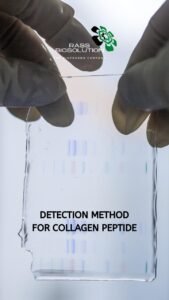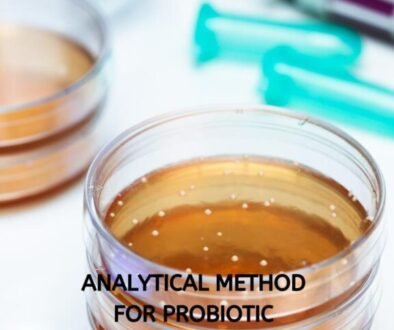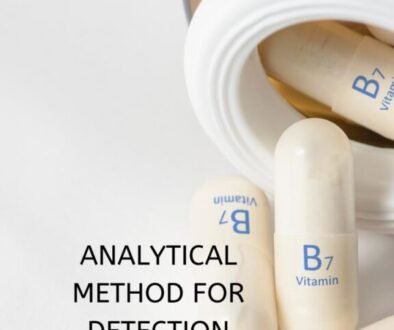TO ORDER COLLAGEN PEPTIDES CONTACT VIA WHATSAPP – +91-8090113353 OR VIA EMAIL – info@rass-biosolution.com

Collagen peptides have gained immense popularity in recent years due to their numerous health benefits, from promoting skin elasticity and joint health to enhancing muscle recovery. As a key protein in the human body, collagen is broken down into smaller fragments known as collagen peptides, which are easier for the body to absorb and use. Whether for use in supplements, beauty products, or functional foods, identifying and verifying the presence of collagen peptides is crucial for manufacturers and consumers alike.
In this blog, we will explore the analytical techniques used to identify collagen peptides, ensuring the authenticity, quality, and effectiveness of products containing these powerful proteins.
What Are Collagen Peptides?
Collagen peptides are short chains of amino acids derived from collagen, a structural protein found in skin, bones, cartilage, and connective tissues. When collagen is broken down into smaller peptides, it becomes more bioavailable, meaning the body can absorb and utilize it more efficiently. This is why collagen peptides are often included in beauty supplements, skincare products, and functional foods.
Why Identifying Collagen Peptides Is Important
The identification of collagen peptides is essential for various reasons:
Quality Control: Ensuring that products contain the correct amount and type of collagen peptides is crucial for maintaining quality and consistency in collagen-based products.
Authenticity: There are several sources of collagen peptides, including bovine, porcine, chicken, and marine animals. Identifying the specific type of collagen is important for consumers who may have dietary restrictions or preferences.
Regulatory Compliance: Many countries have regulations around the content and labeling of dietary supplements and functional foods. Accurate testing ensures that products meet the regulatory standards set for collagen content and quality.
Common Analytical Techniques to Identify Collagen Peptides
There are several analytical methods used to identify and quantify collagen peptides in various products. Let’s take a look at some of the most common techniques:
1. High-Performance Liquid Chromatography (HPLC)
What is HPLC? HPLC is one of the most widely used techniques for separating and quantifying individual components in complex mixtures. In the case of collagen peptides, HPLC can be used to separate different peptide fragments based on their size and chemical properties.
Why Use HPLC?
- Accurate Identification: HPLC is effective at identifying collagen peptides even in complex mixtures.
- Quantification: It allows for the precise quantification of individual peptides, ensuring the product contains the correct levels.
- High Sensitivity: HPLC can detect low concentrations of collagen peptides, making it ideal for high-quality testing.
2. Mass Spectrometry (MS)
What is Mass Spectrometry? Mass spectrometry (MS) is a powerful technique used to identify the molecular composition of a sample. By measuring the mass-to-charge ratio of peptide ions, mass spectrometers can provide detailed information about the size, structure, and sequence of collagen peptides.
Why Use Mass Spectrometry?
- Detailed Peptide Information: MS provides information on the molecular weight and sequence of collagen peptides, allowing for precise identification.
- Sensitivity: It is highly sensitive and can detect low concentrations of collagen peptides, even in complicated mixtures.
- Identification of Collagen Source: MS can sometimes help determine the origin of collagen (e.g., bovine, marine, or porcine) by analyzing peptide markers unique to each source.
3. Gel Electrophoresis
What is Gel Electrophoresis? Gel electrophoresis is a technique that separates peptides based on their size and charge by applying an electric field. Collagen peptides are placed in a gel matrix, and when an electric current is applied, the peptides migrate based on their molecular weight.
Why Use Gel Electrophoresis?
- Peptide Separation: This technique is great for separating collagen peptides by size, providing a visual representation of the peptide profile.
- Simple and Cost-Effective: Gel electrophoresis is relatively simple and affordable compared to other methods, making it ideal for routine testing.
- Qualitative Results: While it provides valuable qualitative data, gel electrophoresis may not always give precise quantification of peptides.
4. Fourier Transform Infrared Spectroscopy (FTIR)
What is FTIR? FTIR is a technique that measures the absorption of infrared light by a sample. Different chemical bonds absorb specific wavelengths of light, allowing researchers to identify functional groups within the collagen peptides. By analyzing these patterns, FTIR can provide valuable insights into the structure of collagen peptides.
Why Use FTIR?
- Non-destructive: FTIR is non-destructive, meaning the sample remains intact after testing.
- Structural Identification: FTIR can help identify the specific molecular structures of collagen peptides, including peptide bonds.
- Quick and Efficient: FTIR is a rapid technique that provides reliable data in a short amount of time.
5. Amino Acid Analysis
What is Amino Acid Analysis? Amino acid analysis involves measuring the amino acid composition of collagen peptides. Since collagen peptides are made up of specific amino acids, this analysis helps determine the presence and concentration of collagen in a sample.
Why Use Amino Acid Analysis?
- Confirmation of Collagen Content: By analyzing the amino acid profile, manufacturers can confirm the presence of collagen peptides and assess their quality.
- Verification of Purity: This method is useful for checking the purity of collagen peptide supplements and ensuring they contain the desired amino acid composition.
Challenges in Collagen Peptide Identification
While the techniques mentioned above are highly effective, there are still some challenges in collagen peptide identification:
- Complexity of Collagen Peptides: Collagen peptides are a diverse group of molecules with varying lengths and sequences, which can make it difficult to separate and identify them.
- Matrix Interference: In complex formulations, such as collagen-based supplements or fortified foods, other ingredients can interfere with the analysis, making it harder to accurately identify and quantify collagen peptides.
- Source Variability: Collagen peptides can be derived from different animal sources (bovine, porcine, marine, etc.), and each source may have slightly different peptide profiles. Identifying the source of collagen can sometimes be challenging.
Conclusion
Collagen peptides are essential for many health-related applications, from skincare products to nutritional supplements. Accurately identifying and quantifying these peptides is crucial for ensuring product quality, authenticity, and regulatory compliance. Analytical techniques such as HPLC, mass spectrometry, gel electrophoresis, FTIR, and amino acid analysis are indispensable tools for manufacturers and researchers working with collagen peptides.
At Rass Bio Solution, we provide advanced testing services to help you identify and quantify collagen peptides in your products. Whether you’re formulating a new supplement or ensuring the quality of existing products, our expert team uses state-of-the-art analytical techniques to guarantee the highest standards of quality and accuracy.
Contact us today to learn more about our collagen peptide testing services and how we can support your business in delivering top-notch products to your customers.


